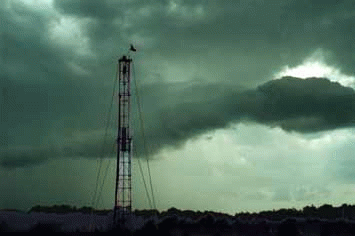We've been fracked by jdial
In this first lecture of a series
that examines various aspects of the practice of hydrofracking, Susan Tierney
came to Boulder from Boston where she consults in energy matters[1]. Her talk consisted largely of reiterating
opposing positions--consumers versus industry, industry versus government,
government versus states--illustrated with charts and graphs showing us how
things stand and in some cases where they're headed. And, as far as energy
production goes, it looks to be pretty much business as usual, with the
addition of fracking, which is showing signs of overtaking coal production.
In this country private markets, as opposed to government,
largely control the development and dispersion of energy. Our country is richly cumbered with energy of
the fossil-fuel variety as well as by sun and wind, although for those renewable
resources we lack not only infrastructure but also, Tierney did not add,
governmental encouragement in the form of subsidies, tax write-offs, and research
grants.
As for gas production, prices were volatile early in the
century and then spiked as fracking as we know it today commenced and demand
grew, but prices plunged with the tanking of the economy in 2008. Since then they've risen some, although not
as high as before. In Colorado since
2000 production of natural gas has doubled.
Much of it, she noted, does not remain here, where prices are not as
rewarding to producers as in other states (and much more so in Europe and Japan,
which producers are pushing to have opened to them; such are the results of
globalization, you know).
Tierney noted that in the East many of the shale formations
and coal veins are located beneath private lands, while in the West much of our
fossil fuels lie under public land. For
nuclear energy the government has control over siting, but as to shale gas the
regulations are much more scattered and, to the extent there are regulations,
under the control of states.
Apart from oversight, despite
industry claims that fracking for natural gas has been ongoing since 1947 (with
the intimation that it's been going on for all this time without harm), is that
today's fracking departs radically from what came before. Traditional gas drilling entailed one well
drilled straight down into a pocket of natural gas trapped in often-shallow sand or
limestone. What has been called "unconventional
hydraulic fracking', the newcomer examined in this series, pursues much smaller,
sometimes microscopic, pockets of gas held within deep-seated and relatively
impermeable shale. (In other words, the
easy stuff's all gone.) Accessing such
pockets requires two stages of drilling for each well. The first descends straight down for five to
ten thousand feet to reach the shale; from there the second departs
horizontally through the shale another five or ten thousand feet and in multiple
directions.
While traditional hydraulic drilling required clearing a
small area of land for one well, accessing the tiny pockets of gas in shale
requires probing the shale with multiple tentacles and from many angles. Thus, areas of 10 to 20 acres must be cleared
for eight to 20 holes to be drilled. And
this will be repeated at other areas overlying that shale formation. According to Truthout, the Marcellus Shale
basin in the northeast is expected to host some 400,000 wells--meaning a lot of acreage
to be cleared.
Measures that the speaker suggested could be taken to ameliorate
impacts of fracking include attention to water consumption and wastewater;
control of air pollution, mainly from methane escape (natural gas is largely
composed of methane, along with such other hydrocarbons as carbon dioxide,
nitrogen, and hydrogen sulfide); and
measures to diminish community disruption during production, including the
cumulative adverse impacts of noise, traffic, and odors on both community and
wildlife. To that I would add more
emphasis to wastewater, which currently when recaptured (and that is seldom enough the case) is forced, fully tainted, into injection wells that are not lined to
withstand high pressures and that are linked to earthquakes ranging in size
from barely perceptible to the 5.6-magnitude quake that was the strongest ever
recorded in Oklahoma[2].
These things could be done, and that would help not only
communities impacted by fracking but animals and ecosystems as well. But will they be done? Tierney's argument seemed to boil down to how
it's largely out of the government's sphere to be able to do much.
Unless you're of the opinion that the market best controls
itself, this brings us to the subject of regulation, federal and/or state. And what a hodgepodge it is. States control what the federal government
doesn't, but hydraulic fracturing is under no oversight exacted by the Safe
Water Drinking Act, the Clean Water Act, or any Superfund program. What control it is under, if you want to call
it control, is the Mining Act of 1872. Signed by President Ulysses S. Grant to
assist donkey-leading hard-rock miners in their efforts, the Act mandates
mining over any other land use, enables lease purchases at prices of two-fifty
to five dollars an acre, and contains no environmental protections at all. After all, it did predate the light
bulb. To be fair, mining regulations are
not nonexistent. Mining that takes place on federal land is
subject to federal, state, and local standards for solid waste, safety, and
fire control (surface mining--specifically not fracking--is also subject to
standards of air and water quality). But
why, in a country where mining depredations can be seen from outer space, is the
Mining Act of 1872 still occupying the place it does in public policy? One reason is Harry Reid. Mining interests from his state of Nevada derive huge benefit from the
law as it stands, or staggers.
Even if the regulation knot were more of a bolus and less of
a raveled thread, however, maybe we should take a moment to think about what
we're doing. Some might consider
pursuing the dregs of natural gas remaining in deep fissures in the earth (as
we pursue other dregs in newly thawed tundra, denuded tar sands, and detonated mountain
tops) to be but a stepping stone to energy sustainability, that golden age that
always seems to hover elusively somewhere out there in the ether. Although the signs of a changing climate may
be becoming more prevalent, still they don't often impact our lives. We go about our business and don't think much
more about the weather than the extent to which it helps or hinders us. We hear about a window of opportunity and
think that we'll get to it any day now.
But what steps are we taking?
The US taxpayer richly subsidizes one of the most profitable industries on earth, that of fossil-fuel energy. Between 1994 and 2009 oil and gas industries in the US received a total of almost $447 billion in subsidies while during those same years renewable energy received less than $6 billion. Subsidies are meant to be a catalyst to emerging technologies. That role should end when the industry gains its feet. To continue with paying subsidies to the energy sector as well as to other established and uber-profitable mega-industries such as agri-business is to exhibit the extent to which these industries own the supplier of their entitlements. Unlike Social Security, extraneous subsidies are invalid and undeserved entitlements.
(Note: You can view every article as one long page if you sign up as an Advocate Member, or higher).






